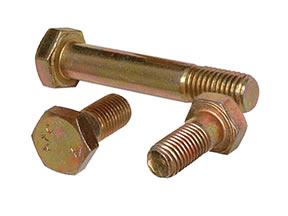
Have you heard of AN bolts? They are commonly used in airplanes. Most airplanes have thousands of fasteners, with AN bolts being one of the most common types. While they look like ordinary threaded fasteners, though, AN bolts adhere to a set of design specifications that distinguishes them from other fasteners.
#1) Army-Navy Specification
They are known as “AN bolts” because they adhere to the Army-Navy specification. The U.S. military developed this specification in the 1940s. With origins dating back to World War II, it’s one of the oldest fastener specifications still in use. AN bolts feature this same specification developed by the U.S. military. You can find hose connectors, tubing connectors, bolts and other fasteners that feature the AN specifications.
#2) Partial Threading
While there are exceptions, most AN bolts have a partially threaded shank. The shank is the cylindrical body of a bolt. Some bolts have a fully threaded shank that’s completely covered in ridges. AN bolts, on the other hand, often have a partially threaded shank. A partially threaded shank allows them to grip into the surface in which they are driven.
#3) Bolt Diameter Comes First
The first number mentioned in the AN specification is the bolt diameter. A typical AN bolt, for example, may be labeled as “AN3-7A.” The “3” in this label refers to the bolt diameter, which is measured in sixteenths of an inch. An AN bolt labeled as “AN3-7A” will have a bolt diameter of 3/16ths of an inch. Regardless, you should refer to the first number in the AN specification to determine the bolt diameter.
#4) A Indicates a Solid Shank
You may discover that many AN bolts have an “A” at the end. What does the “A” mean exactly? The presence of an “A” at the end of the AN specification indicates a solid shank. All AN bolts have a shank. While some of them have a solid shank, others have a shank with a hole in it. A hole in the shank allows AN bolts to support a clotter pin. If you see an “A” at the end of the AN specification, it means the bolt has a solid shank and, thus, doesn’t support a clotter pin.
#5) Typically Made of Cadmium-Plated Steel
AN bolts are typically made of cadmium-plated steel. Cadmium, of course, offers an excellent level of protection against rust and corrosion. Many AN bolts feature a steel core that’s covered in cadmium. With cadmium-plated steel, they are strong, weather resistant and long-lasting.



